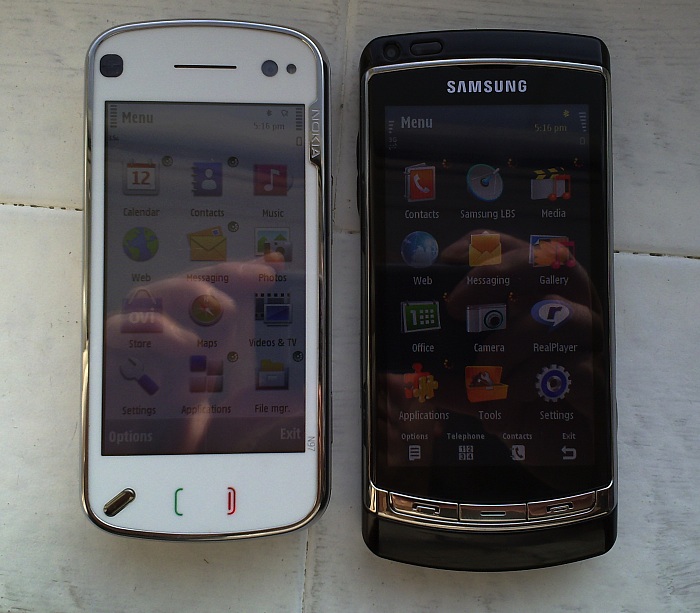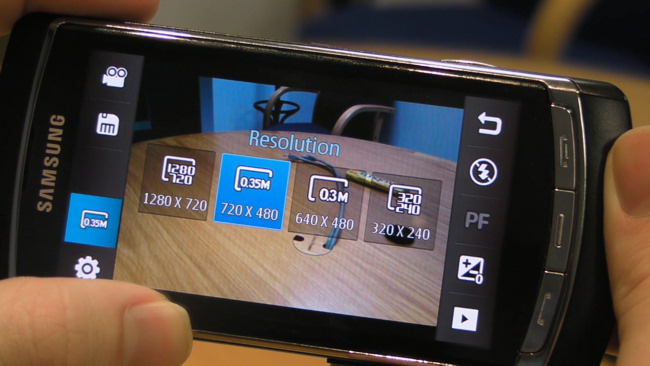* Definition: "Zealot", noun, someone who is over-passionate about a belief device, to the extent that they fail to see positives in other beliefs devices.
First of all, it's absolutely 100% true that the Samsung i8910 HD represents the hardware pinnacle in the Symbian world. It even arguably bests the recently available Sony Ericsson Satio (which has its own issues, of course). And yes, I agree that the i8910 HD's hardware knocks most of Nokia's hardware into a cocked hat, with:
- 256MB of RAM
- 3.7" OLED and capacitive touchscreen
- graphics acceleration and fast processor, plus hardware decoding of a wide range of video formats
- 8mp camera with 720p video recording
- fashionable slate form factor, no moving parts, media-centric focus
Absolutely noone is disputing the i8910 HD's status in terms of being a lust-worthy bit of kit. It's still positively stunning. Read my largely positive detailed review of the Samsung i8910 HD for more on all the upsides of the device. Here it is, next to Nokia's nearest equivalent, the N97:

All things being equal, the Samsung flagship should have trounced everything before it, yet I still find the device sits unused for most of the time in my cupboard. For just a few reasons why, and to give the aforementioned zealots * (definition above) a glimpse into my objective thoughts on the matter, read on:
- There's even less internal flash memory (disk C) than in the much-maligned Nokia N97, leading to all sorts of problems for new users, though most geeks can work around this by using the 8GB/16GB mass memory more and by (see link below) even cooking custom ROMs which leave more flash memory free.
- Lack of kinetic scrolling - there are reasons why S60 5th Edition got itself a bad name and having to use fiddly scroll bars was one of the biggest. With the Nokia N97 and N97 mini having full in-page, in-list, in-dialog kinetic/flick scrolling, S60 5th Edition becomes, at least in part, comparable to the modern UIs on the likes of the iPhone and Android phones. On the other hand, the barebones 5th Edition UI seen here in the Samsung i8910 HD is mostly just as clumsy as in the Nokia 5800 and other more basic 5th Edition phones.
- Lack of support for User Data Preservation (UDP, very handy when updating firmware, as it means you don't have to reinstall everything) or Over The Air updating, both integral parts of Symbian OS but not apparently implemented by Samsung. This latter is just about essential in 2009/2010, every current Nokia Symbian phone has it, for example, and it's a terrifically convenient way of updating. It's also far easier for the average user, not needing a PC and also being reminded automatically when OTA firmware is available.
- There's a noticeable hiss on the audio track of any recorded videos. This can be fixed, after a fashion, by tweaking the mic gain down, though this does reduce overall volume and, most importantly, involves a trip into the weird world of 'secret' menus and general hackery, definitely not recommended for non-geeks.
- The Samsung approach to handling media files remains puzzling. There are still four obvious ways, from the main menu, to browse and play your videos (RealPlayer, Gallery, MediaBrowser and VideoPlayer) - with S60 already arguably being complicated enough, why on earth complicate things with four different applications to access/play the same content?
- Staying with media, one crucial element for any smartphone in the UK these days is full BBC iPlayer support, effectively turning your smartphone into a TV. Alas, Samsung doesn't yet have the right DRM capabilities to handle the BBC's programme download system, restricting you to streaming when in range of Wi-Fi.
- The clumsy TouchWiz 'widget' homescreen may seem like a boon to those upgrading from lesser Samsung feature phones, but it's next to useless for the Symbian power user. You can turn it off in Settings (switch the 'Homescreen theme' to 'Finger use') but then you've got absolutely none of the S60 homescreen plug-ins that we've been used to for years. E.g. Calendar summary, music player control, Wi-Fi scanning, device search. It all feels like a step backwards. thankfully. [thx to comment thread for correction here]
- Possible lack of future support. Samsung have stated that they don't plan on releasing any new Symbian phones in 2010 - and as you'll have gathered from the points here - they haven't exactly been falling over themselves to pour resources behind the i8910 HD in its launch year, 2009. And they're launching a whole new smartphone platform this week ('bada') - yes, Nokia also have Series 40 and Maemo, but they've clearly shown in text and graphics that they plan to increase their use (and support) of Symbian. Buying a phone with no guaranteed future in terms of manufacturer support and updates is like buying a sports car from a company that's about to stop making sports cars.
A smartphone is an investment for most people - and that means buying it for the long haul, a year or two - and it's thus vital to be confident that the manufacturer will still be interested in the device at the end of that period. Now, Samsung haven't defaulted on the i8910 HD yet - and the likes of Nokia don't have a spotless track record here - but it's definitely something to bear in mind. It's worth noting that Italian firmwares keep being rolled out, as do some in the East, but this does bring me round neatly to.... - Distribution weaknesses. Nokia has the reach to make sure its Symbian phones get to all corners of the globe, in all languages and also subsidised on most operators. Samsung has seriously underperformed here, not believing in this device, with the result that it's only officially carried by a handful of networks across the world in a handful of countries. In the UK, a deal was struck with Orange, with appropriate crippling, and to this day if you want a SIM-free i8910 HD you probably have to make do with an Italian unit and change its language yourself using your knowledge of pigeon-Italian to find your way through the dialogs - every single time you update its firmware.
- There are plenty of other issues that need looking at by Samsung. There's even an organised petition, currently with almost 2000 signatures, with a detailed PDF that gives Samsung a to-do list.
It's at this point that the i8910 HD-owning zealots (and I call them this because they seem incapable of appreciating good points from other devices and marques) start directing me to underground geek forums where enterprising i8910 HD owners have got fed up waiting for Samsung and have started creating their own firmware images, mixing and matching the best features into a veritable firmware cocktail, from the various modules officially released by Samsung.
It's not all bad, of course. The II1 firmware, released three months ago, made the i8910 HD eminently useable as a day to day smartphone at long last, provided the owner is prepared to put in a little geek effort setting things up (Si parla Italiano?) and working around a few omissions (relative to the Nokia Symbian flagships).
Do I wish Samsung well with the device? Of course I do. I'm at heart a huge Samsung/S60 fan - or at least I want to be, and I get on famously with the guys at Samsung Mobile Innovator. But Samsung's firmware teams just keep (on the G810, on the 550w, on the INNOV8 and now on the i8910) letting me down with half-baked software and support. Which, at least, is one area where Nokia seem to be trying a heck of a lot harder.
Steve Litchfield, All About Symbian, 7 Dec 2009

